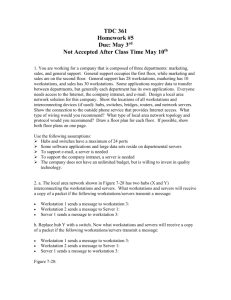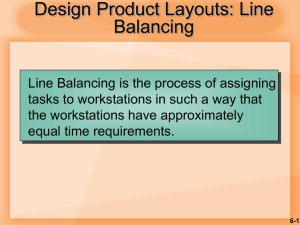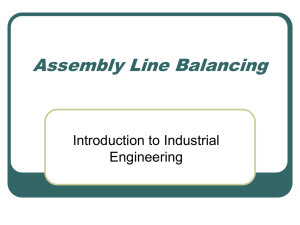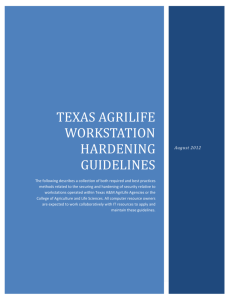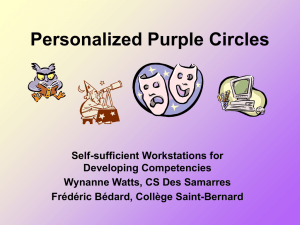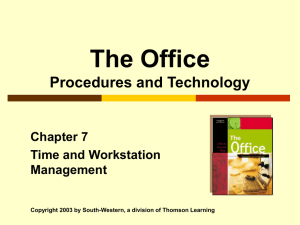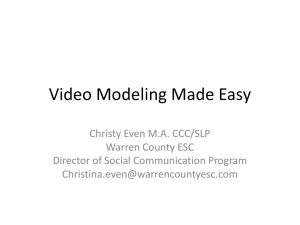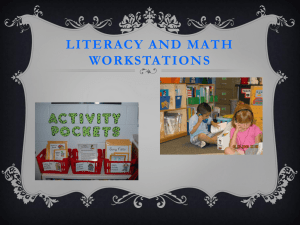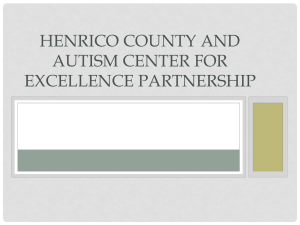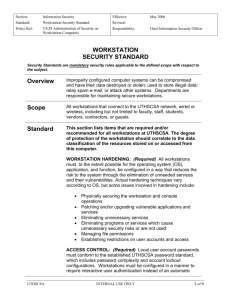Structuring the environments
advertisement
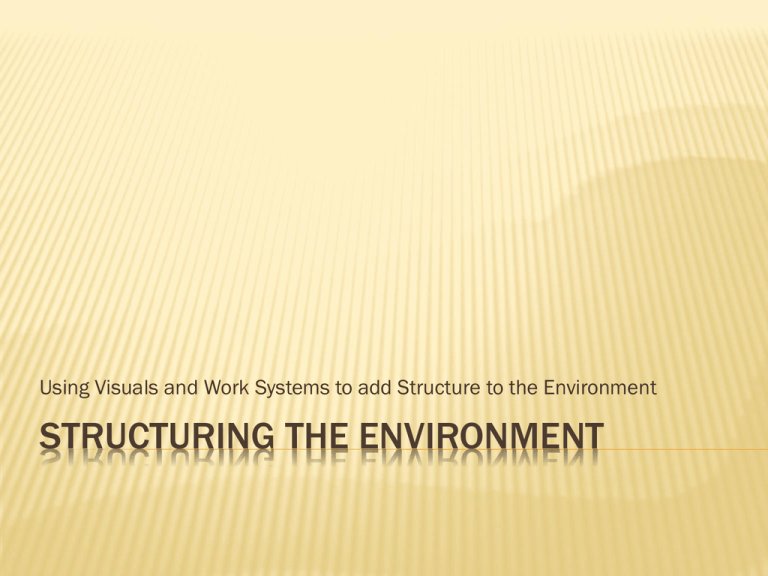
Using Visuals and Work Systems to add Structure to the Environment STRUCTURING THE ENVIRONMENT INTRODUCTION Structuring the teaching environment creates a visual environment that: “Speaks” to the person with ASD Supports the person’s behavior Supports the person’s independent learning WHAT IS STRUCTURED TEACHING? Structured teaching is an approach to behavior management Structured teaching manages and manipulates the environment to promote better communication It teaches organizational skills It is based upon the communication level of the student It involves the physical structure of the environment Contains clearly delineated schedules Utilizes individual work systems with visually clear task orientation (Schopler, Mesibov, & Hearsey, 1995) STRUCTURED TEACHING: WHY? Structuring the teaching adds predictability and consistency to: daily routines Workstation routines Transitions throughout the day Structuring the teaching environment creates a visual environment that: Helps the person with ASD understand Helps the person with ASD be calm When we understand our environment we are not so agitated Helps the person with ASD achieve independence Helps to develop skills Helps as a proactive approach to behavior management STRUCTURED TEACHING COMPONENTS Physical structure Visual schedules Errorless learning activities PHYSICAL STRUCTURE PHYSICAL STRUCTURE Refers to the way we set up and organize the classroom Overall room organization Centers or work stations/systems One-to-one instruction area Small group instruction area Large group instruction area Clear physical & visual boundaries The student with ASD needs to visually “see” what type of learning takes place in each area. Furniture and room dividers Tape on floor Carpet squares Minimize visual & auditory distractions PHYSICAL STRUCTURE Workstation Arrangements 0 sided workstations 1 sided workstations 2 sided workstations 3 sided workstations 4 sided workstations WORKSTATION ANSWERS Answer these questions for the person with ASD What work? How much work? When am I finished? What happens next? VISUAL STRUCTURE WITHIN WORKSTATIONS Arrangements within the workstations Left to right Top to bottom Workstation schedule Materials define the tasks Picture jigs Written instructions Products samples VISUAL SCHEDULES VISUAL SCHEDULES Individual schedules tell students Types of visual schedules Where they should be What activity they should be doing When they will be done with this activity What they will do next Transition object Single picture/photo Picture/word cards Written cards/written lists Formatting Stationary vs. portable Top to bottom Left to right ERRORLESS LEARNING ACTIVITIES LEARNING ACTIVITIES TEACCH’s work systems create a systematic way for students with ASD to receive and understand information Review of 4 key questions What do I do? How much do I do? How will I know I am finished? What do I do when I am finished? LEARNING ACTIVITIES CONTINUED Physical arrangement in work station Left to right Top to bottom Defined “finished” area Typical work system activities: Matching (colors, numbers, letters, etc.) Sorting (functional items) Coallating (functional items) Teach concept of “finished” Teach concept of “first ______, then _____” TASKS Begin with skills he/she comes with Build the work with accomplished skills Look at skills to begin teaching in the 1 to 1 workstation ONGOING ASSESSMENT Data Collection Form Name: Date: Observer: Classroom: Start time: Stop time: Mark your activities in which the child participated each day as V for verbal prompt, P for pointing/gesturing prompt, HoH for hand over hand prompt, or I for independent (no prompts). Workstation Activities Mon. Tues. Weds. Thurs. Fri. Comments MODIFYING WORKSTATION ACTIVITIES Set a mastery target for each workstation activity (100% accuracy at an automatic level for 4 out of 5 consecutive days) Modify activity once master is met Generalize activity series to new settings Other workstations Natural environment INTRODUCING NEW WORKSTATION ACTIVITIES As students shows mastery of 3 or more variations on current workstation activity transfer it to a new setting and replace with a new activity in the current setting Extend on them off current activities Move from 1 to 1 to independent Move from independent to regular classroom Move from regular classroom to home setting All sorting, matching, etc. Functional WORKSTATIONS IN OTHER SETTINGS Workstations can and should occur in many of the following settings. Special education classrooms 1 to 1 workstations Independent workstations General education classrooms Other school settings In the home (bathroom, bedroom, kitchen, dining room, etc.) In the community (church, job, etc.) PARENT COMMUNICATION & INVOLVEMENT TEACCH Parent Logs 1. Keep them positive: 2. Describe the full day: Parents like to hear about their child’s accomplishments and good traits; talk about things that delight you and make the child adorable. Give parents a brief run down of the full day, not just part of it. 3. Share one thing learned: Educate the parents. Include at least one thing learned about their child. Report constructive things that have potential for helping. The issue is not whether it is good or bad, but that it is reported positively and furthers knowledge about the child. PARENT COMMUNICATION & INVOLVEMENT (CONT.) TEACCH Parent Logs (Cont.) 4. Describe the difficulties: Talk about the child’s problems and the difficulties presented in class. Parents know their child has problems; they tend to suffer more when protected by well meaning professionals who withhold information, than when they are treated as equals who can help solve problems. 5. Tell how you managed/taught: Parents want answers! Be sure to include descriptions of anything you find effective, as well as why it works. If you know parents concerns, definitely include information you have relative to their concerns. PARENT COMMUNICATION & INVOLVEMENT (CONT.) TEACCH Parent Logs (Cont.) 6. Send home material: If you develop visual devices that work, send them home along with the explanations of how they were used. Written descriptions are appreciated, but if parents don’t have time to make materials, then they often remain written descriptions. Having devices in hand may help a parent become a parent-teacher. 7. Ask for feedback: Nothing helps the collaborative relationship more than having the educational “experts” genuinely ask parents (the REAL experts) for help. These parents can help you avoid things that have already been tried or obviously won’t work. PARENT COMMUNICATION & INVOLVEMENT (CONT.) TEACCH Structured Teaching Model Parent Log Components: 1. Summarize the day 2. Educate about an area of difficulty 3. Describe it 4. Explain it 5. What did I do about it? 6. What worked? What didn’t work? 7. Ask the questions at the end 8. Write in a positive, constructive way FINAL THOUGHTS The workstation, particularly in conjunction with the individual schedule is a powerful intervention for people with ASD. Creates familiarity and predictability to a wide variety of activities Can build flexibility – activities change but the system remains the same Teaches the “first. . . then. . .” concept FINAL THOUGHTS Workstation activities can be higher level – they need to merely be at the independent level for the person with ASD The key to structuring the environment is to: Create a physical structure with clearly defined boundaries that will facilitate independent, 1 to 1, small and large group learning Design individual daily schedules for your students with ASD Design learning activities that include errorless independent learning
